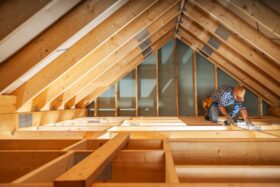Homeowners’ Guide to Roof Ventilation in Napa

Roofing Contractors in Napa, CA, Explain the Purpose and Value of Roof Vents.
How Proper Airflow Extends Roof Lifespan
When most homeowners think about their roofs, they imagine shingles, leaks, or the occasional repair. However, few realize that what’s happening beneath the surface plays just as critical a role in their roof’s long-term health and indoor comfort. Ventilation allows fresh, cool air to enter your attic while pushing out hot, stale, or moisture-laden air. This airflow balance keeps your attic from overheating in the summer, prevents moisture buildup in the winter, and reduces the overall stress on your roofing materials.
In Napa, where temperature swings, coastal moisture, and sunny summer days all collide, it isn’t just a nice-to-have. It’s a safeguard for your home’s energy efficiency, structural integrity, and long-term savings. In this guide, we’ll explore how roof ventilation works, identify warning signs to watch for, and provide steps to ensure your system is up to the task.
What Is Roof Ventilation and How Does It Work?
Roof ventilation is the system of air movement that allows your attic to “breathe.” It draws in cooler, fresh air through intake vents (usually at the soffits) and pushes hot, moist air out through exhaust vents (like ridge or gable vents). This constant circulation of air prevents heat and moisture buildup that can severely damage your roof over time.
Key Components of a Roof Ventilation System
-
Soffit Vents: Installed under the eaves, these bring fresh air into the attic.
-
Ridge Vents: Run along the peak of the roof, allowing warm air to escape.
-
Gable Vents: Placed on the gable ends of the roof to help with exhaust in certain layouts.
-
Baffles: Ensure insulation doesn’t block the soffit vents, keeping airways clear.
A properly balanced system incorporates both intake and exhaust, creating a natural airflow that reduces attic heat in the summer and moisture accumulation in the winter.
Signs You Might Have Roof Ventilation Problems
Because most, if not all, of these systems and roof designs are out of sight, it can often be difficult to tell if your home has an issue or is just responding to the elements outside. However, there are a few red flags homeowners can look for to help address poor ventilation, including:
-
Uneven Temperatures or High Energy Bills: If your home is difficult to cool in summer or heat in winter, it may be because your attic is retaining excessive heat or moisture. Poor ventilation forces your HVAC system to work overtime.
-
Shingle Damage: Excessive attic heat can cause shingles to warp, blister, or crack, leading to early deterioration and potential leaks.
-
Mold or Mildew in the Attic: Trapped humidity in winter can lead to mold growth on rafters or insulation. This is a sign your attic isn’t drying out properly.
-
Rust or Corrosion on Roofing Nails: Condensation buildup often causes metal fixtures in the attic to rust, especially in poorly ventilated spaces.
-
Ice Dams in Winter: Although Napa rarely sees snow, elevated homes or properties near mountains may experience ice dams. These form when attic heat melts snow, which then refreezes at the eaves, backing up water under your shingles.
The Impact of Proper Airflow
When your attic is well-ventilated, it creates a balanced environment that protects every layer of your roofing system. Cooler attic temperatures help shingles last longer by minimizing surface heat, while dry insulation maintains its effectiveness, keeping your home more energy-efficient.
Proper airflow also reduces the risk of rot in rafters and sheathing, supports a more stable indoor climate, and lowers the chance of unexpected, costly repairs. In short, ventilation isn’t just about comfort; it’s about extending the lifespan of your entire roof.
5 Steps to Improve Your Roof Ventilation
If you suspect your attic isn’t breathing properly, there are several practical steps you can take, from minor upgrades to full-system installations, to optimize airflow and extend the life of your roof.
1. Schedule a Professional Roof Inspection
Before making changes, have a licensed roofing contractor evaluate your existing ventilation setup. They’ll assess your:
-
Intake and exhaust balance
-
Attic moisture and temperature
-
Insulation placement
-
Roofing type and architecture
This initial inspection can uncover blocked vents, missing components, or layout issues.
2. Install or Unblock Soffit Vents
Many older homes in Napa have insufficient or painted-over soffit vents. These vents are critical for drawing in fresh air. Clearing or upgrading them is often the most impactful fix.
3. Add Ridge or Gable Vents
If your home lacks adequate exhaust, a ridge vent (a low-profile vent that runs along the roof’s peak) may be added to allow warm air to escape. Gable vents are another common solution for homes with triangular roof ends.
4. Use Ventilation Baffles (Chutes)
Baffles are plastic or foam panels that maintain an air channel between the insulation and the roof deck. These are especially useful if insulation has been packed too tightly and is blocking airflow through the soffit.
5. Upgrade to Powered Ventilation (if needed)
In cases where natural ventilation is insufficient, due to architectural limitations or high attic volume, solar-powered or electric attic fans can be installed to enhance air circulation.
It’s essential to note, however, that powered solutions should only be installed when passive (natural) systems are insufficient, and should always be balanced with proper intake vents to prevent creating negative pressure in the attic.
Choosing Your Roofing Contractor
Now that you understand the importance of proper roof ventilation, its impact on your home, and the signs to look for if it’s lacking, what steps should you take next? While some issues could be handled with a DIY approach, it’s always best to rely on an experienced roofing contractor to handle this scale of work.
Not every roofing company is experienced in developing effective ventilation strategies. When choosing a contractor, ask:
-
Do they inspect both intake and exhaust vent systems?
-
Can they calculate and recommend the ideal CFM (cubic feet per minute) of airflow for your roof’s square footage?
-
Will they work around the specific needs of your roofing material (metal, tile, shingle, etc.)?
-
Do they also inspect insulation, baffles, and attic conditions?
-
Are they experienced with Napa-specific ventilation and permitting?
Your roof is a significant investment that should last 20 years or more with proper care. Roof ventilation might not be visible from the curb, but it plays a silent, critical role in extending your roof’s lifespan and your home’s overall health.
About Modern Method Roofing
Modern Method Roofing has proudly served Napa homeowners for over 50 years, delivering expert roofing solutions tailored to the region’s unique climate and architectural styles. If you’re not sure whether your attic is adequately ventilated, the team at Modern Method Roofing can help. We specialize in ventilation upgrades, repairs, and full roofing systems designed for Napa’s unique climate. Contact us today for a ventilation inspection or roofing consultation.
I think about your company
every time the rains come.
You guys did a good job.
Thanks for the gutter guards.
I'd recommend you to everyone. Thank God for Modern Method Roofing!
- Judy Moore

Modern Method Roofing,
helping people
for more than 60 years
Contact us
Featured Video





5.0 out of 5.0 based on 4 Positive Review(s)

